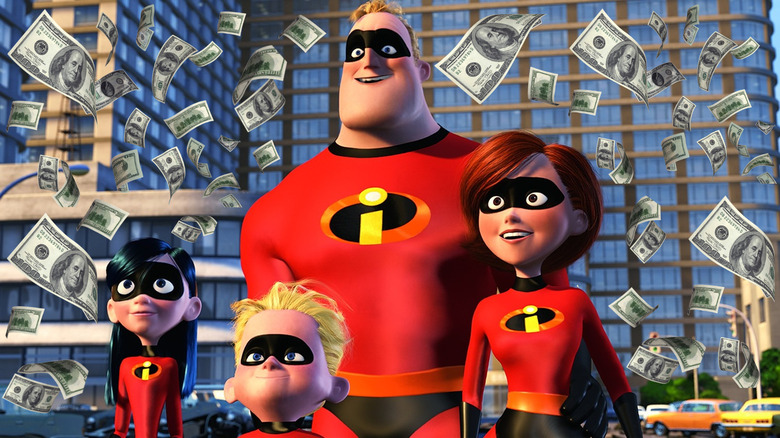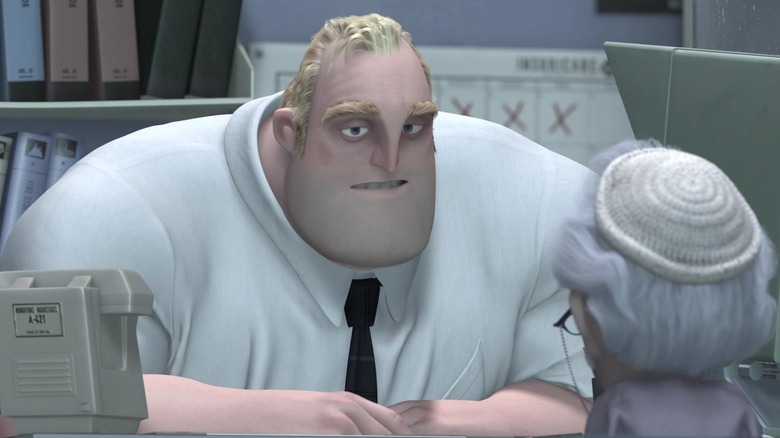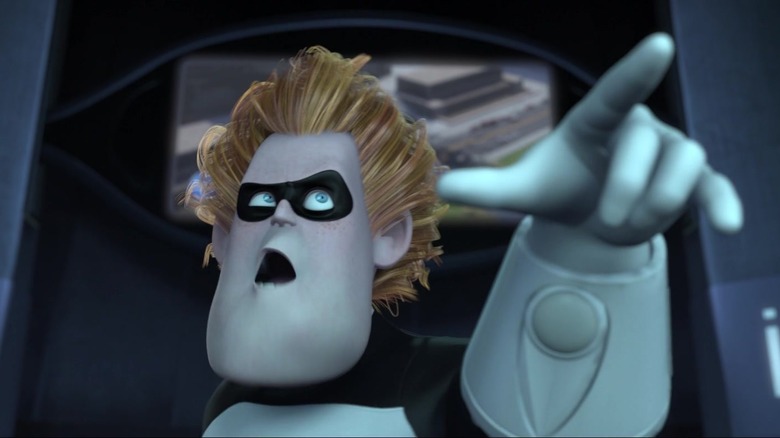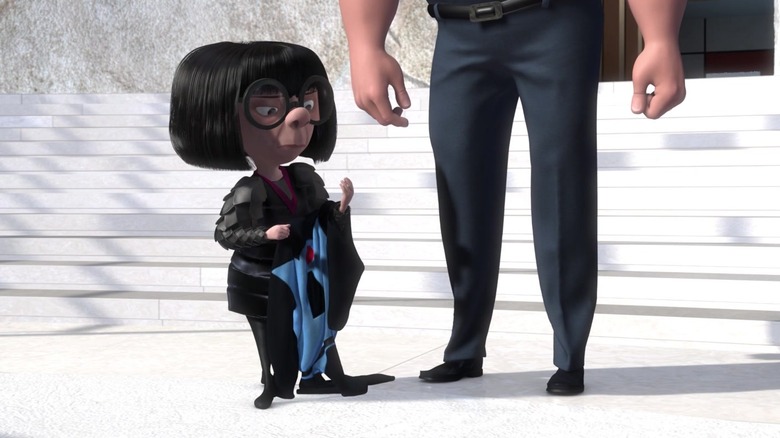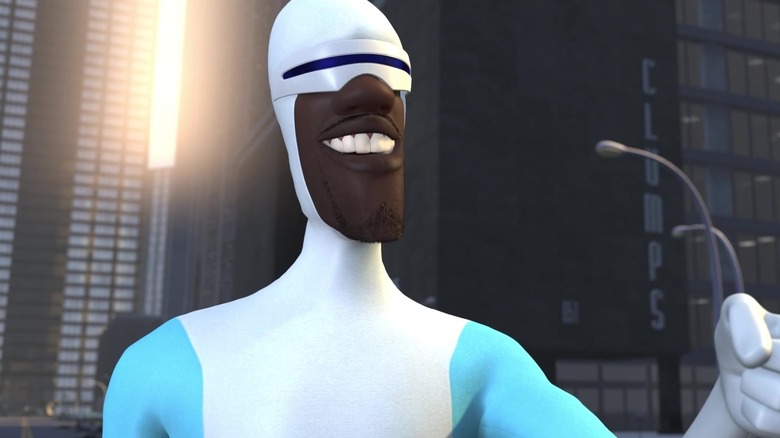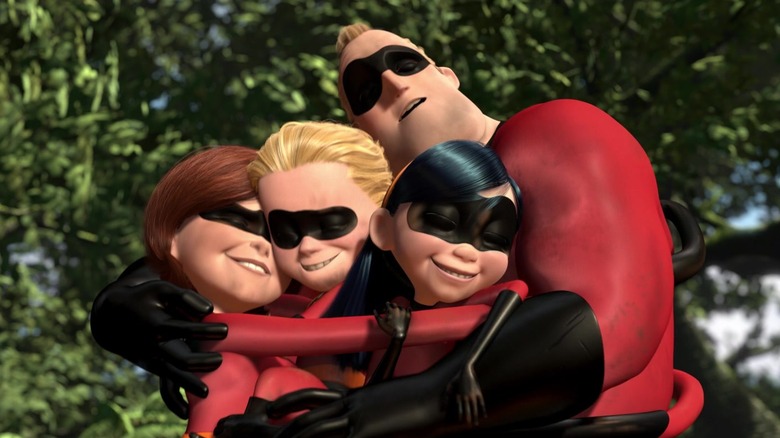20 Years Ago, The Biggest Original Superhero Movie Ever Saved The Box Office
(Welcome to Tales from the Box Office, our column that examines box office miracles, disasters, and everything in between, as well as what we can learn from them.)
"I got my heroes secondhand, from television and movies, to a certain extent. When fans ask if I was influenced by issue 47 of Whoeverman, I have no idea what they're talking about." Those are the words of director Brad Bird discussing his 2004 smash hit "The Incredibles" with Michael Barrier. "I'd be astonished if anyone could come up with any truly original powers that were at all interesting any more," the filmmaker added.
Somewhat ironically, 2004 was also when superhero cinema reached a turning point thanks to "Spider-Man 2" making a whopping $784 million worldwide, building off the back of Sam Raimi's first hit "Spider-Man" in film 2002, which was building itself off of hits like "X-Men" and "Blade." Superheroes were about to become more popular in the mainstream than they had ever been before. In another bit of irony for Bird, a man who admittedly did not read comic books and questioned whether or not one could do much of anything wholly original in the genre, "The Incredibles" wound up becoming the biggest original superhero film of all time.
Less than a decade earlier, "Toy Story" helped establish Pixar as a hugely bankable brand in cinema. Crucially, the studio had never used humans as lead characters in a film, instead leaning on the likes of toys, fish, and monsters. That was all about to change, though, as Bird's family of costumed heroes was about to do what no original superhero film has done before or since.
In this week's Tales from the Box Office, we're looking back at "The Incredibles" in honor of its 20th anniversary. We'll go over how the film came to be, how it became a major challenge for Pixar, what happened when the movie hit theaters, what happened in the years following its release, and what lessons we can learn from it all these years later. Let's dig in, shall we?
The movie: The Incredibles
"The Incredibles" centers on Bob Parr, his wife Helen, and their three children. Before starting a family, Bob and Helen were among the world's greatest crime fighters, known as Mr. Incredible and Elastagril. 15 years later, they are merely civilians as the world has turned on superheroes. So, they try to live a normal life with their kids Violet, Dash, and Jack-Jack. Everything changes, however, when Bob, restless with his daily grind, gets the chance to suit back up as a mysterious message summons him to a remote island for a secret mission.
At the time, Bird was coming off of the disappointing commercial failure of "The Iron Giant," which served as his feature directorial debut. The good news for him was that his previous movie had been very well received by critics and the moviegoers who saw it, despite having underperformed. As for "The Incredibles," Bird had come up with the idea for the film years before he pitched it to Pixar after being encouraged by John Lasseter (the former head of Pixar and, as it happened, a friend of Bird's from college). Bird ended up signing a multi-film deal with the studio and it was off to the races.
When it came to crafting his heroes, Bird wanted to focus more on the characters, rather than just what would look the coolest on screen. In that same chat with Michael Barrier, Bird recalled:
"The part that I'm interested in is all the personal stuff. I tried to base the powers on family archetypes. The father is always expected to be strong, so I had him have strength. Moms are always pulled in a million different directions, so I had her be elastic. Teenagers are insecure and defensive, so I had her be invisible and have protective shields. 10-year-old boys are hyperactive energy balls, so I had him be speed. And babies are unknown — they may have great powers, they may have none."
He couldn't do everything himself, but Bird generally has a very specific vision for his films. When it came to translating his vision for "The Incredibles," he had interesting ways of getting his ideas across. Teddy Newton, who drew many of the characters in the film, explained in the production notes how Bird described them to him:
"Brad would simply describe the characters to me — he wouldn't use too many adjectives, but he would often do an impression or a voice for them. Sometimes the voice alone would put enough pictures and ideas in my head. It's like when you listen to the radio and you start to imagine what the person would look like. You get inspired and everything starts to take shape."
The Incredibles faced several major challenges during production
It should be noted that the making of any movie is difficult, as is the nature of the business. Even so, Pixar's style of CGI animation was still relatively new at this point, and computing power was a fraction of what it is now, which presented challenges to Bird and his "Incredibles" creative team. In a 2005 interview with IGN, he explained why doing a human story was more difficult than what Pixar had done previously with films like "A Bug's Life" and "Finding Nemo":
"Even in hand drawn animation, humans are widely considered to be the most difficult to execute, because everybody has a feeling for how they move. If your goal is just to be funny then you can do something simple like 'The Simpsons' and 'South Park.' But if you're trying to be dramatic and put your characters in jeopardy and have them feel pain and regret and complexity, then you have to be very careful as to how you put them on screen."
Bird also made the important distinction that "We didn't want it to look real, we wanted it to feel real." This emphasis on character and an emotionally grounded story would prove to be key and at the heart of most successful Pixar films, regardless of the genre. Still, new methods had to be developed to get the film made on budget and on time.
Beyond that, working in the well-trodden realm of superhero stories has some drawbacks. So many of them have been made over the years, and those just those of the Marvel and DC Comics variety. Even coming up with superhero names for "The Incredibles" proved difficult, as Bird explained in a 2004 interview:
"I would just write down pages and pages of names that I thought sounded like superheroes and were fun, and then I would narrow the list down. We then had to clear the names to make sure they were not already used. If anybody publishes 10 issues of something from his basement in Ohio, if he has registered it, we cannot use it."
Bird and his crew even had to make a deal with Warner Bros. because a character named Elastagirl had appeared in the pages of DC Comics years earlier. Still, they managed to make it work, in the process putting together one heck of a voice cast led by Craig T. Nelson ("Poltergeist") as Bob, Holly Hunter ("Raising Arizona") as Helen, Samuel L. Jackson ("Unbreakable") as Frozone, and Jason Lee ("Chasing Amy") as the villainous Syndrome, with Bird personally voicing famed superhero costume designer Edna Mode. It all came together better than Bird or Pixar could have imagined.
The Incredibles' financial journey
It's worth pointing out that Hollywood was facing a bit of a down period when "The Incredibles" came out, with the fall 2004 box office lagging behind the same period in 2003 when movies like "The Matrix Revolutions" and the holiday classic "Elf" were in the middle of their impressive box office runs. As such, a hit was needed to help turn things around. Fortunately, Disney and Pixar had a true crowd-please up their sleeves with "The Incredibles," courtesy of Brad Bird.
"The Incredibles" reached theaters on November 5, 2004, riding a wave of near-universal praise from critics. Thanks to the likes of "X-Men" and "Spider-Man," superheroes were in vogue in a way they hadn't been since Tim Burton's "Batman" became a box office juggernaut in 1989. But even that was more of a revolution for a single hero, rather than the concept of costumed heroes in general. The newfound love of superheroes helped Bird's film top the charts with a heroic $70.4 million debut. It represented the second-biggest debut for an animated movie ever up to that point, trailing only the behemoth that was "Shrek 2," which finished as 2004's top-grossing movie globally.
Even as "The Polar Express," "Seed of Chucky," and "Bridget Jones: The Edge of Reason" arrived the following weekend, the Parr family stayed strong, holding firmly in the number one spot with another $50.2 million. The film didn't have to surrender the crown until "National Treasure" arrived the following weekend. Even then, it continued to hold extremely well, all the way into March of 2005.
"The Incredibles" finished its run with $261.4 million domestically to go with a stellar $370 million overseas for a grand total of $631.4 million worldwide. Against a $92 million production budget, it was a massive success. The only movies that made more that year were the aforementioned "Spider-Man 2" and "Shrek 2," as well as "Harry Potter and the Prisoner of Azkaban" ($795.6 million). But those were all sequels. Bird and Pixar accomplished this with a film that wasn't based on any pre-existing material, at least not directly.
The Incredibles rides the superhero wave to great success
At the time, "The Incredibles" was Pixar's second-biggest hit behind only "Finding Nemo" ($936 million). More importantly, no original superhero movie in history had ever made more money. While superheroes had been popular on screen at various times, it was almost always based on pre-existing material from comic books. To that end, even after another 20 years of superhero dominance at the box office, no other original superhero movie has made more money than Bird's animated classic. That's both wildly impressive and a little hard to believe.
Interestingly, "The Incredibles" was so good that it caused a little bit of trouble for Fox's "Fantastic Four" movie in 2005, which was based on the Marvel Comics property of the same name. Mr. Fantastic, The Invisible Woman, The Human Torch, and The Thing, it's no secret, were loosely mirrored by the Parr family. Nevertheless, none of the live-action takes on "Fantastic Four" to date have matched what was accomplished by "The Incredibles." As Bird said, he wasn't trying to make something totally original, he was just going for good. Mission accomplished.
The film's success also helped pave the way for Disney's acquisition of Pixar in 2006, rather than just being the studio that distributed the animation house's films. At the same time, in the years that followed, the presence of superheroes in popular culture would only become more prevalent. To that end, Christopher Nolan's "Batman Begins" also hit theaters in 2005, which teed up the ball for bigger things to come with "The Dark Knight" in 2008.
That same summer, "Iron Man" opened in theaters and was an unexpected hit, paving the way for the Marvel Cinematic Universe. That was the true point of no return. Even so, in the two decades since "The Incredibles" arrived, few superhero films have resonated so universally with audiences. It remains a shining example of what the genre can accomplish. It can (and should) be more than just shameless commercial entertainment.
The lessons contained within The Incredibles' success
All good things must end. That's not to say superhero movies aren't going to keep happening but, as we learned in 2023, the era of presumed superhero dominance is behind us. Audiences will no matter automatically show up for these films just because a Marvel or DC logo is attached. The common denominator seems to be the ones that are generally considered very good do well, like "Deadpool & Wolverine." The ones that are more broadly considered bad, like "Joker: Folie à Deux," do poorly. Obviously everyone feels differently but, when looking at the broader consensus, this is the big differentiator.
A big part of that has to do with recycling ideas. How many Batmans can we have? How viable is Superman as a franchise, really? How many times can we get a new Spider-Man and have it work? When was the last time we had a new live-action superhero franchise successfully launch in theaters? Outside of the biggest of big heroes, the genre is struggling a bit to find a more consistent path forward. "The Incredibles" suggests that maybe, just maybe, original concepts might be worth exploring in this well-trodden genre. That's easier said than done, to be certain, but good things like this don't happen if studios just keep going back to the well.
Naturally, when it works, sequels are going to happen. "Incredibles 2" was a monster success when it hit theaters in 2018, taking in $1.24 billion worldwide — nearly double that of its predecessor. Unsurprisingly, Disney and Pixar are now working on "Incredibles 3." That's just the nature of the beast as it exists. It would be unwise not to make sequels to movies that bring in more than $1 billion.
That said, a key part of the creative cycle here is allowing for the exploration of new ideas, new characters, and original concepts while exploiting the hits as they come. This is true both for Pixar as an animation studio and for the superhero genre as a whole. IP and pre-existing ideas aren't always king. Sometimes, an original concept, one that is proudly inspired by things that already exist, can win the day.
